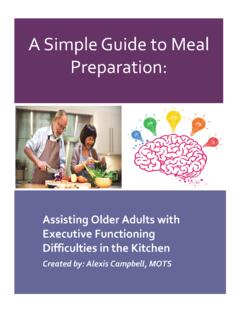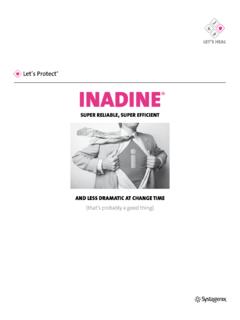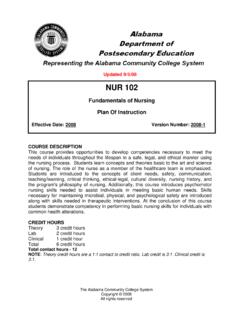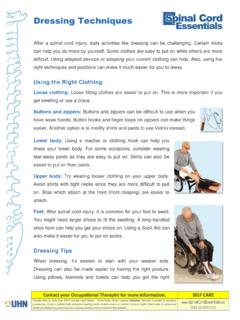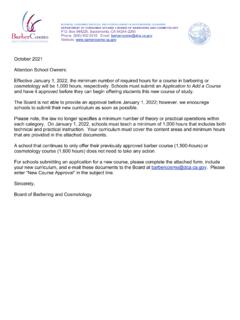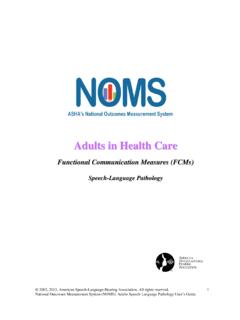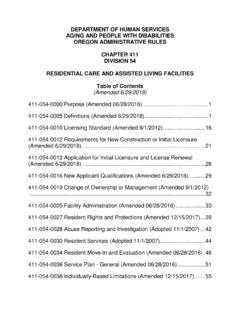Transcription of energy conservation techniques for daily living
1 Adaptive Equipment and energy conservation techniques During Performance of Activities of daily living Problem: A wide range of diagnosis can affect the performance of activities of daily living (ADLs). The performance of these activities; feeding, dressing, and bathing to name a few are an essential part of our daily lives. An individual s ability to function in daily activities is often dependent on physical and cognitive health. The use of adaptive equipment and energy conservation techniques can make all the difference in making these important daily tasks possible and effect one s perception and quality of their life. Adaptive Equipment Adaptive equipment is used to improve functional capabilities. Adaptations can assist someone in their home or out in the community, ranging from longer, thicker handles on brushes and silver wear for making them easier to grasp to a powered wheelchair.
2 Below is a chart including various diagnosis and examples of adaptive equipment that could greatly benefit individuals experiencing similar circumstances. The equipment listed will promote functional independence as well as safety during performance of ADLs. Diagnosis Adaptive Equipment Rationale for Equipment Price Range Website/Resource Link to Purchase Equipment Joint Replacement (THA/TKR) Reacher This assistive device can help in accessing spaces that may be hard for the individual to reach otherwise. Frequent sitting and standing (bending more than 90 degrees) are not recommended for individuals with a recent joint replacement. This tool will allow the individual to grasp an object further away without movement of lower extremities. $ - $ Sock aid After having a joint replacement, it is very important to limit a large range of motion at the hip/knee.
3 Putting on socks requires bending and reaching, however, using a sock aid can greatly limit the range of motion required when performing this task; sliding the sock over the sock aid and lowering it to the floor using attached ropes. Sock aids can greatly ease dressing tasks after a joint replacement. $ - $ Long handled shoehorn Many times, when putting shoes on it is convenient to bring your foot closer to you to make the task easier, however, after a joint replacement, it is recommended to avoid stepping backwards, crossing your legs, or bending more than 90 degrees at the joint. A long-handled shoehorn is medically necessary to ensure unnecessary movements are minimal. $ - $ Raised toilet seat Minimizing bending the operated joint is extremely important after having a joint replacement surgery. Using adaptive equipment to limit range of motion at the hip/knee will allow for adequate time for healing and reduce risk of injury.
4 $ - $ Bathroom grab bars This assistive device can provide support and stability for an individual after a joint replacement. Maintaining balance during bathing by using grab bars with textured handles will greatly increase safety and decrease fall risks on slippery surfaces. $ - $ Unsteady Gait Tub transfer bench Shaking and poor balance are common symptoms of Parkinson's disease, ** . Individuals who easily have loss of balance need extra support to compensate for the energy that is constantly being used during tremors and shaking. A tub transfer bench will provide the additional support that is necessary during bathing. $ - $3, Walker A walker can have a profound effect on stability for individuals with walking difficulties. Stiffness is often another common symptom that occurs with unsteady walking, making this assistive device medically necessary.
5 A walker can act as a support for functional mobility while greatly increasing safety. $ - $ Tremors Weighted utensils The heaviness of weighted utensils reduces the effect of tremors by steadying the hand. Also help with lack of coordination by providing more sensory feedback. Significantly smoother movements make it easier to scoop up food and bring it to the mouth. This assistive device is medically necessary during self-feeding for someone with tremors. $ - $ Scoop dish Tremors can have a profound impact on coordination and control of the arms and hands. A scoop dish can be used to avoid food being pushed off the edge of the bowl and prevent spills during feeding and eating. This adaptive equipment is important for feeding to be an independent task. $ - $ Chronic, progressive illness Power wheelchair An electric wheelchair is an assistive device that can give the individual a sense of independence when complications increase.
6 Electric wheelchairs are highly adjustable to patients specific needs and can assist with pressure relief, postural alignment, sitting tolerance, and independent repositioning. This adaptive device will increase independence and safety. A power wheelchair is capable of adjusting to specific needs of the individual, making it a medical necessity. $1, - $19, Ramp Progressive muscle weakness and paralysis are symptoms that are sometimes seen at end stages of debilitating illnesses. A ramp is an assistive device which is often placed over stairs or uneven surfaces. A ramp is medically necessary to allow an individual using a wheelchair to get in and out of their home. $ - $ Hospital bed Treatment options are often limited for progressive diseases, making the comfort and safety of the patient a top priority. Without a hospital bed there is an increase for complications to arise such as bedsores, thrombosis, pneumonia (due to lack of upright position), UTI, and osteoporosis, making a hospital bed necessary for a chronic, progressive disease.
7 $ - $1, Arthritis Electric can opener An electric can opener can make it both safer and easier for getting the lid off a can. By using this assistive device an individual with arthritis will avoid putting the extra tension and stress on their bones. It is medically necessary to prevent exacerbations and discomfort, which cause intense stiffness and discomfort in the joints. $ - $ Long- handled sponge This assistive device will limit the need to reach when bathing. Arthritis symptoms including joint stiffness, pain, and inflammation make the long-handled sponge is medically necessary to support independent grooming and bathing for an individual with a limited range of motion. $ - $ Rocker knife with built up handle The rocker knife requires less pressure than a regular utensil when cutting food, the built-up handle will add less stress on inflamed or weak joints.
8 Arthritis is especially prevalent in the hands and fingers; this assistive device is medically necessary for self-feeding and independence. $ - $ Low Visual Acuity Contrast tape Outlining edges of counter tops, steps, coffee tables, doorways, and bathtubs/showers with blue tape makes them easier to distinguish. Without contrasts, the likeliness of falls and accidents are increased. Contrast tape is medically necessary to ensure safety of individuals with decreased visual acuity. $ - $ Bump dot stickers This adaptive tool with give the individual tactile cues to hit appropriate buttons when using the microwave, oven, stove, remote, or phone in their home. Without these stickers, turning on the wrong burner on the stove or setting the temperature too high on the oven is much more likely, making them medically necessary for safety.
9 $ - $ Portable electric magnifier A portable electric magnifier will allow the individual to read labels, prescriptions, and appointment dates. This device can be used easily in the home by either laying it flat over the surface and sliding it along to read or slide camera over the text with the screen set up behind the material being read and read off the device screen. $ - $ energy conservation energy conservation techniques is a less physical way of adapting the way daily activities within the environment. Making simple adjustments to daily routines can improve energy efficiency, and ultimately conserve energy throughout the day. energy conservation techniques can be applied to any aspect of life; at home, work, leisure, and even rest/sleep. The 6 P s below are important to keep in mind to help conserve energy .
10 energy conservation techniques - 6 P s 1. Prioritize: Set realistic goals and prioritize daily activities 2. Plan: Break down task into stages 3. Positioning: Sit down and take rest breaks, avoid prolonged movements and tiring posture. 4. Pace yourself: Allow extra time to complete an activity and don t rush 5. Positive attitude: Concentrate on all the things you can do 6. Pursed lip breathing: Inhale through nose, exhale through mouth The areas of feeding, dressing, and bathing are assessed as examples of applying ideas of energy conservation techniques to everyday life: Eating & Feeding Plan ahead and avoid rushing Schedule meal prepping throughout the week Organize grocery list by aisle Shop at less busy times Sit when preparing meals Make use of electrical appliances; blender, dishwasher, etc.


